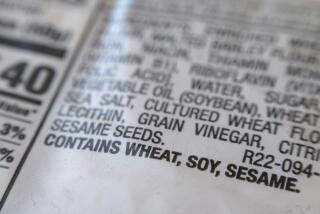Dysfunctional Tahineh
- Share via
The sesame plant isn’t exactly handsome, but it’s rich: Its tiny seeds are anything from 44% to 60% oil. And a very useful oil it is. It has a mild nutty flavor (if you toast the seeds before pressing them, you get a darker oil with a stronger flavor) and it happens to resist oxidation, so you don’t have to worry about rancidity as much as you do with other oils.
When you’ve pressed the oil out of the seeds, you can even eat the leftover solids. Sweeten them up and press them into a cake and you have that crumbly Turkish sweet called halva. Mix in some pistachios if you want to get fancy.
If you grind sesame seeds into a paste and don’t separate the oil from the solids, you have the cooking ingredient called tahineh. It’s unhappy with itself in this form, though. You may have noticed the dysfunctional way tahineh separates into oil and proto-halva if you don’t stir it regularly.
In Middle Eastern cooking, tahineh is flavored with garlic and lemon juice to make a rich, mouth-filling sauce that can be dribbled onto falafel or mixed with pureed garbanzos, making hummus. There are other vegetable purees flavored with tahineh, the best-known being the eggplant-based baba ghannouj.
This kind of tahineh sauce was used in medieval Arab cooking too, often made with vinegar instead of lemon juice and flavored with herbs and spices such as mustard, thyme or saffron. Surprisingly, though, it was never mixed with pureed vegetables; it was used only on fish. Fish baked in tahineh sauce is still a common dish in the Middle East.


